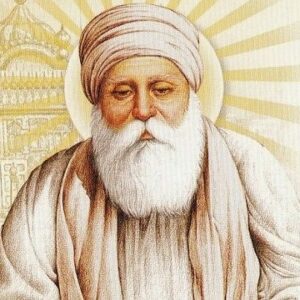The third of Sikhism’s ten Gurus was Guru Amar Das. He spent the majority of his life as a devout Hindu before being inducted into Sikhism fairly late in life. He followed in the footsteps of his god-fearing, devout Hindu parents and developed into a devout Hindu himself. Amar Das, who had a spiritual bent from an early age, was regarded for his kindness and serenity. He heard the daughter of Guru Angad Dev sing Guru Nanak Dev hymns when he was already an elderly man in his sixties. He was moved by the hymns, and he went to see Guru Angad right away. Amar Das chose to follow the guru despite the fact that the guru was much younger than he was, and he served the guru with the fullest devotion despite his advanced age. The guru chose his disciple to be his successor after being deeply moved by the simplicity, diligence, and knowledge of the student. Guru Amar Das, the founder of the Sikhs, wrote numerous hymns, campaigned to advance women’s rights, and improved the Langar system.
Early Childhood & Life
On May 5, 1479, Guru Amar Das was born in Basarke Gillan, Amritsar, Punjab, India. He was the oldest child of Mata Lachmi and farmer and trader Tej Bhan. His parents were ardent vegetarians and Hindus. He grew up to be a devout Hindu, following in their religious footsteps.
Later Years of Guru Amar Das
He too became a trader, just like his father. He regularly went to temples to pray and took part in religious ceremonies with great earnestness as a devout Hindu. He frequently made pilgrimages to Jwalamukhi and Haridwar.
He first heard Bibi Amro, the daughter of Guru Angad Dev, singing some Guru Nanak Dev hymns while he was in his early sixties. Bibi Amro was wed to a member of Amar Das’ family. He heard these hymns frequently and was fascinated by them. He asked about them and learned about Guru Angad Dev as a result.
After learning about the guru, he was so influenced that he decided to go see him. He resolved to spend the rest of his life serving Guru Angad Dev after meeting the guru and becoming a devout Sikh. He actively started helping the guru and giving back to the neighborhood.
Even though he was becoming older, he still got up early to accomplish challenging physical tasks. He was so engrossed in his devotion that he completely let go of his ego and sense of pride in the guru’s service.
He was particularly interested in the langar system, or communal kitchen, and he urged everyone to participate in the communal meal, regardless of caste or religion. Guru Angad Dev named him his successor because of his dedication to upholding the Sikhi values and disseminating Sikhi knowledge.
On March 29, 1552, Guru Angad Dev passed away, and Guru Amar Das took over as the Sikhs’ spiritual guide. He established Goindwal, a brand-new town that Guru Angad Dev had founded, as his headquarters. Soon, a lot of followers went to the new guru to meet him and ask for his blessings.
Datu, one of Guru Angad Dev’s sons, however, declared himself to be the genuine guru. He challenged the elderly guru in front of the followers and kicked him so hard that he fell to the ground out of jealousy for Guru Amar Das. Guru Amar Das, however, remained silent. He merely left Goindwal and went back to his own village.
A group of devoted Sikhs went to his village and asked him to return after being horrified by the events. As a result, Guru Amar Das went back to Goindwal and took up his guru duties.
The langar system was strengthened by Guru Amar Das. Before being allowed an audience with the guru, everyone, regardless of faith, caste, or social class, had to first eat a meal at the community kitchen with other people. Prior to meeting the guru, Emperor Akbar also had lunch at the langar.
In order to forward the cause of Sikhism, Guru Amar Das established the Manji and Piri system. He chose 52 female Piris and 94 male Manji to spread the teachings of Sikhism to the populace. He was a prolific author who wrote several hymns, of which the Sri Guru Granth Sahib contains 907.
The Big Work of Guru Amar Das
The Manji (male Sikh preachers) and Piri (female Sikh preachers) systems for disseminating Sikhism’s teachings among the populace were established by Guru Amar Das. The Manjis and Piris were given permission to instruct other men and women in the fundamentals of Sikhism, respectively. Seventh Sikh Guru Har Rai expanded the system by creating an additional 360 Manjis.
Personal Legacy & Life
Guru Mata Mansa Devi and Amar Das were married and had four kids together. He picked Ram Das, one of his disciples, to marry one of his daughters.
He had a long life and passed away on September 1, 1574, at the ripe old age of 95. He designated Ram Das as his successor before he passed away.
Estimated net worth
The estimated net worth of Guru Amar Das is unknown.


